Serviços Personalizados
Journal
Artigo
Indicadores
-
 Citado por SciELO
Citado por SciELO -
 Acessos
Acessos
Links relacionados
-
 Citado por Google
Citado por Google -
 Similares em
SciELO
Similares em
SciELO -
 Similares em Google
Similares em Google
Compartilhar
DYNA
versão impressa ISSN 0012-7353versão On-line ISSN 2346-2183
Dyna rev.fac.nac.minas v.72 n.157 Medellín jan./abr. 2009
EVALUATION OF WHITE CEMENT COLOURED WITH ULTRAMARINE BLUE PIGMENT
EVALUACIÓN DEL DESEMPEÑO MECÁNICO DEL CEMENTO BLANCO COLOREADO CON PIGMENTO AZUL ULTRAMAR
JUAN CAMILO RESTREPO GUTIÉRREZ
Cement Group and Building Materials, National University of Colombia, Medellín, jcrestre@unalmed.edu.co
OSCAR JAIME RESTREPO BAENA
Cement Group and Building Materials, National University of Colombia, Medellín, ojrestre@unalmed.edu.co
JORGE IVÁN TOBÓN
Cement Group and Building Materials, National University of Colombia, Medellín, jitobon@unal.edu.co
Recibido para revisar mayo 20 de 2008, aceptado octubre 14 de 2008, versión final noviembre 11 de 2008
ABSTRACT: In this study the performance of white cement coloured with ultramarine blue pigment was evaluated. The performance is explained through of the mineralogical changes occurring in the replacement of cement by pigment in percentages of 5, 10, 15 and 20%. It produced concrete and pastes to be studied to 3, 7, 28 and 90 days of standard cured.
It was found that the ultramarine blue pigment to come in touch with the C3A of cement and water, allows the formation of large quantities of primary ettringite (disordered and dispersed in the matrix), thank to its sulphur content. It implies an increase of mechanical strength of the concrete blended whit Ultrramarine blue pigment as much as 45% to 90 days of standard curing.
KEYWORDS: Blended white cement, Hydration products, ultramarine blue pigment, ettringite, pozzolan.
RESUMEN: En el presente trabajo se evalúa el desempeño mecánico del cemento blanco coloreado con pigmento azul ultramar y se explica su desempeño a partir de las modificaciones mineralógicas acaecidas por la sustitución de cemento por pigmento en porcentajes de 5, 10, 15 y 20%. Se fabricaron hormigones y pastas para ser estudiados a 3, 7, 28 y 90 días de curado normal.
Se encontró que el pigmento Azul Ultramar al entrar en contacto con el C3A del cemento y el agua, y debido a su contenido de azufre, permite la formación de grandes cantidades de etringita primaria (desordenada y dispersa en la matriz), lo cual se traduce en un incremento de la resistencias mecánicas de los hormigones sustituidos con Azul Ultramar hasta en un 45% a 90 días de curado normal.
PALABRAS CLAVE: Cemento blanco pigmentado, hormigones coloreados, azul ultramar, etringita primaria, cemento adicionado.
1. INTRODUCTION
Pigments are powdery materials consisting of very small particles, in some cases with sizes less than 1 μm. Pigments colour depends on its nature, mineralogical and chemical composition, manufacturing process, purity, particle forms and size distribution, specific surface area and other properties. Colour in concrete can be obtain in two different ways, the first one to paint its hardened surface and the second one by adding colouring agents to the mix during its manufacturing process or during the process of hardening.
Ultramarine blue is an inorganic pigment, it is a silicate aluminium complex with sodium and sulphur, and it is formed from kaolin in a thermic process.
B. Kronne [1] made a comparative study of the influence of various mineral pigments, such as ultramarines and oxides, in improving the mechanical properties of concrete products. This work reported a significant increase in compression strength, to 7 days, in concrete using ultramarine blue pigment. Restrepo [2] and Sweep [3] explain this phenomenon by two possible hypotheses, the packaging of pigment in the paste gaps or from an ion exchange between the pigment and cement.
These experiments indicate that the ultramarine blue pigment reacts directly with calcium hydroxide free in the hydration of Portland cement, forming a complex of aluminium, calcium and silicon, which make an additional resistance to the product, assuming behaviour like natural pozzolans.
Present work is focused on evaluating and identifying the crystallization and the transformations that are generated in the microstructure of concrete from the mixing of white cement with ultramarine blue pigment in different replacement proportions of white cement and to identify and understand the changes occurring in the pigment that is in contact with the alkaline solution, produced during cement hydration.
2. MATERIALS AND METHODS
It was used white Portland cement Type I according to ASTM C 150-02a (4), supplied by Cementos Argos S. A., Nare plant. It was compared with ASTM C 1157-02 (5) and NTC- 1362 (6) and It could be classified as a hydraulic cement for general construction and as White Portland Cement type 1B respectively. Its main physical and chemical characteristics are outlined in Table 1.
Table 1. Physical and chemical properties of used cement
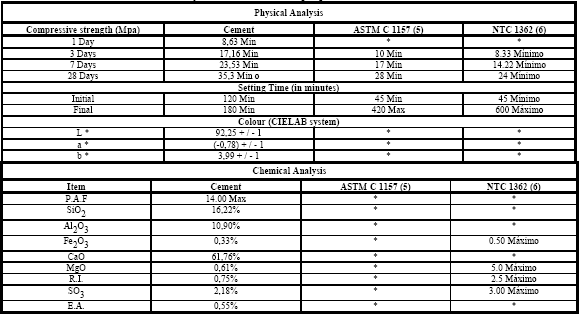
Ultramarine blue pigment U-301, is a commercial pigment of Nubiola Colombia S.A. Quartz standardized from of Toxement, Eucofiller type was used as fine sand, coarse grain size, between 10 and 20 Tyler mesh (crystalline silica up to 90%). As coarse aggregate an alluvial deposit of Medellin river with igneous and metamorphic rocks was used, with maximum size defined as 12.5 mm or ½ ".
In the concrete of reference (Mixture type 1) the following dosage was used = 1:1.8:2.65 and water/cement (w/c) = 0,493. Where: 1 - white cement, 1.8 – fine material and 2.65 – coarse material. The water/cement (w/c) guarantees the settlement required. Cylinders were immersed in a tank of water cured until the day that they were failed.
Mixture type 2 (5% replacement) - White Cement = 3,667 kg. Pigment = 0,193 kg. w/c = 0,493 - 1.93 litres.
Mixture type 3 (10% replacement) - White Cement = 3,474 kg. Pigment = 0,386 kg. w/c = 0,493 - 1.93 litres.
Mixture type 4 (15% replacement) - White Cement = 3,281 kg. Pigment = 0,579 kg. w/c = 0,493 - 1.93 litres.
Mixture type 5 (20% replacement) - White Cement = 3,088 kg. Pigment = 0,772 kg. w/c = 0,493 - 1.93 litres.
For mineralogical analysis and the determination of their possible phase transformations pastes were manufactured, according to the different amounts of pigment replacement. The water/binder relation (w/b) was defined through the test for normal consistency of hydraulic cement, NTC 110 (7) or ASTM C187 (8).
For this analysis it was used a scanning electron microscope (SEM) Jeol JSM LV 5910, with accelerating voltage of 30 KV, vacuum system combined with mechanical pump, filament of tungsten, with secondary electron detector (SE), retro projected (BSE) and X-ray type EDS and WDS; of National University of Colombia, Medellin. Analyses were performed in the way of high vacuum of the equipment.
3. RESULTS
3.1 Mechanical Strength
In Table 2 and Figure 1 it is presented the results for the compressive strength of concrete cylinders with and without replacement of pigment.
Table 2. Compressive strength of the pigmented concretes
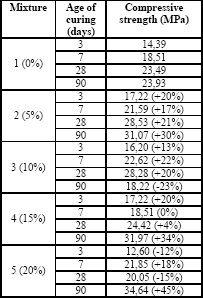
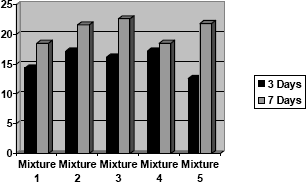
Figure 1. Mechanical strength of concrete cylinders
It is possible to see that there is a clear trend on pigmented concrete with ultramarine blue to have greater strength compared to concrete reference as much as 45%, it becomes more significant over cured time and the percentage of replacement. The results also suggest that the early strength are diminished with substitutions above 15%, however, the finals strength are benefiting from very high rates of replacement obtaining profits by 34% and 45% in the resistance to the concrete with replacement 15% and 20% respectively, compared to concrete without any replacement.
3.2 Mineralogical Analysis
Figure 2 presents the images obtained in SEM for the different samples for 7 days of cured.
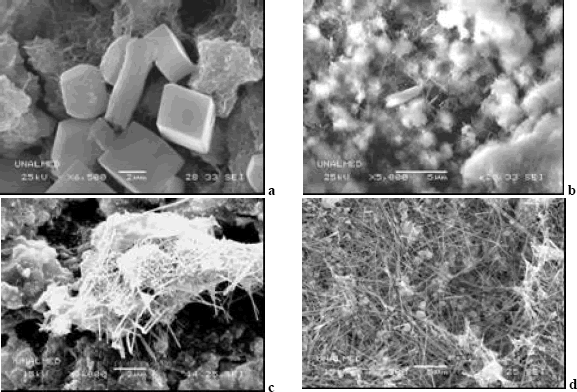
Figure 2. Different pastes mineralogy to 7 days of cured: mixture 1, b:2 mixture, c:mixture 3, and d:mixture 4
This figure shows that ettringite is most important mineralogical phase (in quantity) and it increases as the percentage of pigment in mixtures grows. This is because the possible chemical reaction between the sulphur content in the pigment with the tricalcium aluminate (C3A) present in the white cement, in the presence of water. In the photographs c and d of Figure 1 is clear the relationship ettringite/pigment.
With the excess of ettringite and C3A (natural in white cement) is carried out the formation of monosulfoaluminate (Afm) (Figure 2-d).
Figure 3 shows SEM images obtained in the different samples for 28 days of cured. a: mixture 1, b: mixture 2, c:mixture 3 and d: mixture 4.
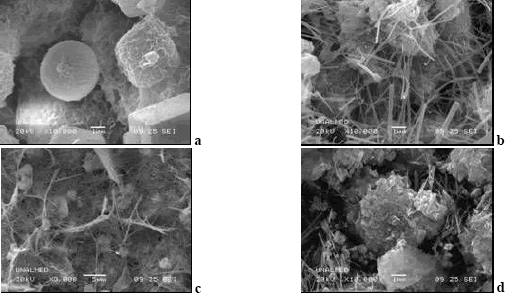
Figure 3. Different pastes mineralogy to 28 days of cured: mixture 1, b: 2 mixture, c: mixture 3, and d: mixture 4
Figure 3-a did not show the presence of structures like ettringite, while that another mixes showed growth in the number of ettringite crystals with the increasing of the percentage of replacement of cement by pigment. Actually, Note that all the ettringite formed is disorderly, and intertwined in the matrix. Even now to this time is possible to find fragments of pigment without reacting and the crystals of ettringite are forming from them (Figure 3-d).
Figure 4 shows the SEM images obtained in the different samples for 90 days of cured.
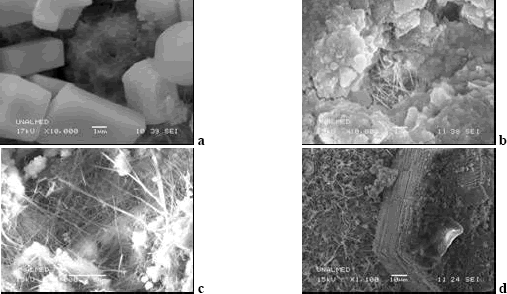
Figure 4. Different pastes mineralogy to 28 days of cured: mixture 1, b: 2 mixture, c: mixture 3, and d: mixture 4
At the age of 90 days of cured (Figure 4-a) it was recognised, for first time, in this study ettringite in the mixture 1 (no added pigment). In the other mixtures, at this age, to carry on been clear the greatest formation of ettringite with increasing replacement of cement by pigment, It was observed crystals ettringite (Figure 4-d) even now with few magnifies. As is shown in Figure 4-c remaining pigment without reacting and monosulfoaluminate has been formed.
4. DISCUSSION
The formation of ettringite needles for all mixtures with pigment is directly proportional to the increase in the replacement of cement by pigment and age cured. Additionally, it is possible to see the link between the pigment and these crystalline structures, because from them the structures in the form of needles were formed.
The formation of ettringite within the matrix of concrete is produced through the sulphur content of pigment and the large quantity of C3A present in the white cement used in the tests. The pozzolanic effect of the ultramarine blue could not be verified through the mineralogical tests because we did not find a decrease on portlandite quantity with the increase of the substitution the cement by pigment.
It was found that an improvement in the mechanical strength of the concrete occur with increasing replacement of cement by pigment and age cured. This shows that the formation of primary ettringite is responsible for the increasing resistance of concrete through the inter-growing of theses crystals. This agrees with the explanation for the development of resistance makes Taylor of cements over sulphates [9]. This work fits well with research [10 and 11] that have been made nowadays with the aim of reducing the emission of gases during the manufacture of cement working with oversulphate belitic cements to produce large amounts of ettringite and increase the early strength.
It is possible that the pigment also carries the physical effect of filling pores in the matrix thanks to its small particle size and that this mechanism in some measures is providing for the development of resistance on concrete blended. While this is perfectly possible, the work of Giraldo and colleagues [12] show that substituting different pigments only in the ultramarine blue mortars increases the resistance compared with the reference, this suggests that is possible that exist a physical effect but that is the chemical effect which controls the increase in mechanical strength. This means that the Ultramarine Blue is an active addition, although it does not have the typical behaviour of pozzolan materials.
For 90 days of curing persist fragments of pigment without reacting to the case of mixtures with 10% and 15% replacement of cement by pigment, which could be suggesting that the mechanical resistance may increase more over time until the C3A hydrated are consumed entirely.
Another topic that should be explored is the durability of concrete made with this type of blended cement especially concerning the carbonation as was proposed by authors such as Zhou & Glasser [13]
5. CONCLUSION
Concrete with replacement of cement by Ultramarine Blue pigment shows increases in the values of compressive strength near to 45% in comparison concrete reference (0% substitution). These improvements are directly proportional to the percentage of replacement and cured age.
The C3A of cement reacts with Ultramarine Blue pigment, in water presence, to form a large number of ettringite structures with needle habits, which create a very dense structure by the intersecting needles that provide significant mechanical resistance to concrete. The amount of ettringite increases directly with increasing the percentage of replacement of cement by pigment.
The images obtained by SEM allowed identify the relationship between the pigment and ettringite. These needles of ettingite are formed from the pigment particles.
REFERENCES
[1] KROONE, B. Las reacciones entre el cemento Portland hidratado y el Azul Ultramar. Division of Building Research, Commonwealth Scientific and Industrial Research Organization, Melbourne, Australia , 1968. [ Links ]
[2] RESTREPO BAENA, O.J. Pigmento Azul Ultramar, Caracterización del proceso y producto. Doctoral Thesis, Oviedo Un iversity, Oviedo, Spain. 1995. [ Links ]
[3] BARRER, R.M. Y RAITT, J.S. Intercambio iónico del Ultramar. Universidad de Aberdeen, Agosto de 1954. [ Links ]
[4] ASTM C 150-02a.Standard Specification for Portland Cement. [ Links ]
[5] ASTM C1157. Standard Performance Specification for Hydraulic Cement. 2002. [ Links ]
[6] NTC 1362. Cemento Pórtland Blanco. Normas Técnicas Colombianas para el Sector de la Construcción– I. [ Links ]
[7] Norma Técnica Colombiana (NTC) 110. Método para determinar la consistencia normal del cemento. [ Links ]
[8] ASTM C187. Standard Test Method for Normal Consistency of Hydraulic Cement. 1998. [ Links ]
[9] H.F.W TAYLOR. Cement Chemistry. 2nd edition. Thomas Telford, 1997. 459p. [ Links ]
[10] GLASSER, F. & ZHANG, L. High-performance cement matrices based on calcium sulfoaluminate- belite compositions. Cement and Concrete Research 31 (2001) 1881 – 1886. [ Links ]
[11] QUILLIN, K. Performance of belite-sulfoaluminate cements. Cement and Concrete Research 31 (2001) 1341 – 1349. [ Links ]
[12] GIRALDO, C.; TOBÓN, J. I.; RESTREPO, J. C. Y RESTREPO, O. J. Resistencia a la compresión de morteros pigmentados con azul ultramar. Scientia Técnica, Año XIII, No 36, septiembre de 2007. Universidad Tecnológica de Pereira, ISSN 0122-1701. Pp 893 – 896. [ Links ]
[13] ZHOU, Q. & GLASSER, F. Kinetics and mechanism of carbonation of ettringite. Advances in Cement Research 3 (2000). 131 – 136. [ Links ]














